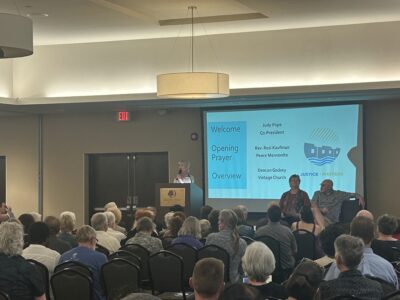Lawrence representatives say expansion of K-10’s west leg will pay for itself, dismiss toll as counterproductive

photo by: Elvyn Jones
A motorist turns off Kansas Highway 10 at the Kasold Drive intersection during an afternoon rush hour on July 10, 2018. The section of K-10 west of U.S. Highway 59 to Wakarusa Drive has become the busiest section of the still two-lane K-10 west leg since the four-lane east leg opened in November 2016.
Local advocates who want the state to prioritize expanding Kansas Highway 10’s west leg to four lanes are using the state’s own figures to argue that the project will pay for itself, but they say adding a toll to use the road would be counterproductive.
A number of representatives of the City of Lawrence, Douglas County and the local chamber of commerce testified Nov. 8 before the Joint Legislative Transportation Vision Task Force at a public hearing in Olathe about the importance of completing the South Lawrence Trafficway by upgrading K-10 to four lanes from the U.S. Highway 59/Iowa Street interchange to North 1800 Road.
The task force is charged with making recommendations in January to the Kansas Legislature about what should be in the state’s next transportation plan and how it should be funded.
Public meeting Wednesday, Nov. 14
In his testimony, Jonathan Marburger, project engineer with the City of Lawrence, testified that when the state’s current T-Works transportation plan was being developed a decade ago, each project proposed for inclusion was assigned an economic benefit score. The K-10 east leg from U.S. 59 to East 23rd Street in Lawrence had the highest score of any project considered for T-Works with an estimated $3.7 billion economic impact. That was more than a 20-fold return on the $180 million cost to construct the four-lane east leg. The east-leg improvement created business opportunities such as Venture Park and Rock Chalk Park, Marburger wrote in his testimony that the economic return continues with the proposed KTen Crossing development south of K-10 on U.S. 59.
“Revenue generated from job creation, sales taxes and rising property values supports a statewide budget, impacting every Kansas citizen,” Marburger states in written testimony submitted to the task force.
Lawrence City Commissioner Matthew Herbert and Lawrence chamber of commerce president Larry McElwain told the task force the same kind of return could be expected from the west-leg expansion.
McElwain said Tuesday that he added the caveat that making the SLT a toll road would decrease the west leg’s economic return. The Kansas Department of Transportation is reviewing a tolling option for the SLT as part of the environmental impact study it is conducting as a requirement to expanding the west leg to four lanes. In addition, the task force heard testimony in September about the possibility of using tolls to fund expansion of stretches of state highways like the SLT from two to four lanes.
Herbert agreed with McElwain’s assessment of a toll road’s adverse effort on economic development. He added that a toll would be unfair because it would make Lawrence the only major city in the state with a bypass that was tolled. Tolls would also encourage motorists to use city streets rather than the SLT, he said.
“If you toll that road, you defeat the entire purpose of having an advantageous route to avoid congestion,” Herbert said. “You would have a bypass that doesn’t serve any purpose.”
Although his presentation focused on the economic impact of the west-leg expansion, the most compelling reason to add lanes to the west leg was safety, Herbert said. KDOT figures show that traffic on the west leg has doubled and that accidents have tripled since the SLT east leg opened two years ago, he said.
The Lawrence delegation attempted to document that increased congestion and traffic with a video taken from a drone during a recent morning rush hour, which showed west-leg traffic backed up 1.5 miles, Herbert said. However, they weren’t able to show the video to the task force because of time constraints.
Herbert said he was disappointed in the task force’s response to the presentation from the Lawrence delegation.
“The task force’s response was not what I expected from a professional environment,” he said. “When we gave our testimony, half of those in the room were playing on cellphones. If I behaved in that manner when I was at a City Commission meeting, I would expect to get called out.”
The task force has wrapped up its nine-stop tour of the state for public hearings. It will meet Nov. 28-29 at the Capitol in Topeka to discuss the recommendations it will make to the Legislature.







